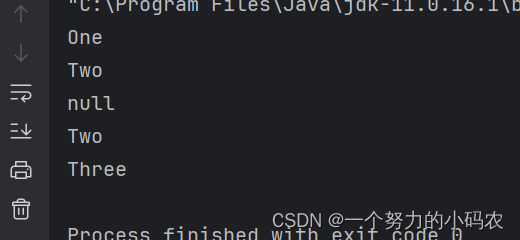//LRU(Least Recently Used)缓存算法是一种常见的缓存淘汰策略,
// 它的基本思想是保留最近被访问过的数据,淘汰最久未被访问的数据。下面是一个使用Java实现的简单LRU缓存算法:
import java.util.LinkedHashMap;
import java.util.Map;
public class Test_A29<K,V> extends LinkedHashMap<K,V> {
private final int capacity; // 声明LRU缓存的容量
public Test_A29(int capacity){
super(capacity,0.75f,true);// 初始化LinkedHashMap,设置容量、负载因子和访问顺序为true
this.capacity=capacity;//初始化缓存容量
}
// 重写removeEldestEntry方法,实现LRU缓存的淘汰策略
@Override
protected boolean removeEldestEntry(Map.Entry<K, V> eldest) {
return size() > capacity; // 判断是否需要移除最老的条目
}
// main方法,程序入口点
public static void main(String[] args) {
Test_A29<Integer, String> cache = new Test_A29<>(2); // 创建Test_A29对象,容量为2
cache.put(1, "One"); // 将键值对(1, "One")放入缓存
cache.put(2, "Two"); // 将键值对(2, "Two")放入缓存
System.out.println(cache.get(1)); // 获取键1对应的值,并打印
System.out.println(cache.get(2)); // 获取键2对应的值,并打印
cache.put(3, "Three"); // 将键值对(3, "Three")放入缓存,触发LRU淘汰最老条目
System.out.println(cache.get(1)); // 获取键1对应的值(已淘汰),打印null
System.out.println(cache.get(2)); // 获取键2对应的值,仍在缓存中,打印"Two"
System.out.println(cache.get(3)); // 获取键3对应的值,打印"Three"
}
}























 1272
1272











 被折叠的 条评论
为什么被折叠?
被折叠的 条评论
为什么被折叠?








